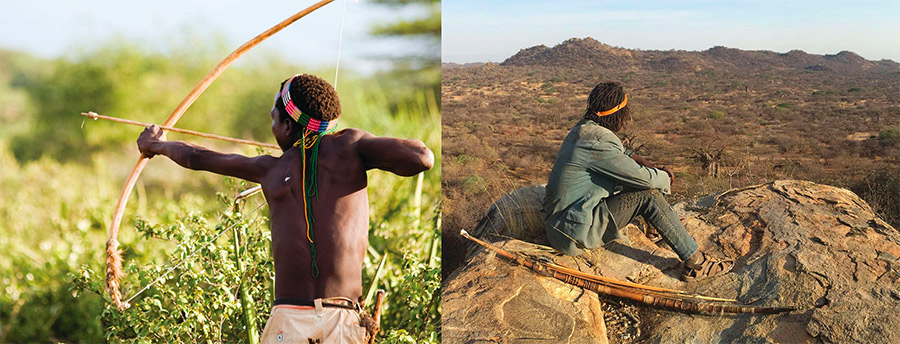Modern hunter-gatherers living in terrestrial Africa environments have a strikingly similar basic toolkit to the Middle Stone Age groups. They have advanced projectile weapons—all encountered African hunter-gatherers had bows and arrows. They all have mastered the miniaturization of projectile tips, making them light and easily cast long distances. Most have and use poisons for killing prey. They all have an advanced knowledge of pyrotechnology—they can make fire, use fire to cook and smoke (preserve) food, can use fire to modify materials, use fire to modify their environment, and of course use fire to prolong the day and keep back predators. They make dwellings out of the available materials in their environments. They have various means to carry loads. They use natural minerals to make pigments, and a common one is ochre. They know and use medicinal plants. They make ornaments and shape projectiles to a set style.
The modern hunter-gatherer toolkit

Modern Hadza men from Tanzania hunting with traditional bows. Image credit Shutterstock (left) and Jacob Harris (right).
What are the raw materials of the modern hunter-gatherer tool kit?
The raw materials of the hunter-gatherer are drawn solely from the natural environment. Stone, bone, antler, horn, tusk, wood, plant material, and shell from bird and mollusk offer a surprising diversity of materials to create a tool, which is at its most fundamental level something to solve problems.
Modern hunter-gatherers have tools with modified sharp edges that then are used to do other things. Stone tools are used to cut wood, butcher animals, strip bark, and so on. Having a sharp sturdy edge is of extraordinary value. These also form the basis of stabbing and projectiles weapons, and modern humans have a diversity of types such as knives, hand cast spears, atlatls, and bows and arrows. These are essential to hunting and warfare. Bone is also fashioned into tools such as projectile points. Hunter-gatherers have carrying tools, such as ostrich egg flasks and bags. They have huts, normally made of plant material such as branches and leaves, and brush. They have poisons to ease the killing of animals. This is the typical modern human hunter-gatherer kit in Africa, and it is normally light and can be carried by a single person from camp to new camp.
Modern human hunter-gatherers in Africa for the most part move camp regularly—they have what scientists call “high residential mobility.” They may move camp on average 10 to 30 times a year in a strategic manner, almost always camp next to a source of water, wood for firewood, and food. The annual range of a single band can be very large, covering hundreds of square kilometers. Their societies normally have at least two levels of primary structure. The first is called the band or local group, and this is the main foraging unit. The average size is about 25 members, but this can vary. Some have very flexible band membership, while others less so. The equivalent among chimpanzees would be what primatologists call the troop, and paleoanthropologists assume that the last shared common ancestor also had this band-troop structure. Bands are grouped into ethnolinguistic groups or what are sometimes called tribes. These speak the same language, share dress codes and other symbols of group affiliation, share kinship characteristics, and are tied together by formal rules of marriage exchange that are normally outgroup from the band but within-group for the tribe. Chimpanzees lack this tribal structure.
What is modern hunter-gatherer society like?
Our ethnographic record from Africa shows us that a terrestrial modern human hunter-gatherer has a very effective but light toolkit, an advanced command of fire, a rich culture of symbolic behavior and institutions for managing their lives, and at least a two-level sociality. All of this is unique to modern humans. When, how, and why these features evolved in the hominin line.
Hunter-gatherers in Africa are reliant on culture as their primary form of adaptation. This culture is composed of technology, language, belief systems, kinship systems, social structure, and rules and norms. Since all modern humans have these characteristics, we can safely assume that the origin population of modern humans did as well. Given that, the paleoanthropologist has some clear research questions to ask—when, why, and how did these features of modern humans evolve? Archaeology has a key role in tackling these questions.
We are fortunate in that cultural anthropologists have provided vast amounts of detail on African hunter-gatherers in the form of ethnographies, and we can use this information as a guide for setting up some expectations of what to look for in the archaeological record. What do we know?
All of that record comes from hunter-gatherers who lived off primarily terrestrial resources. But some hunter-gatherers focus on coastal and riverine and lake resources, and there is an archaeological record for this, but our ethnographic record is at best sparse in Africa, and there are some shared characteristics of a modern human as a terrestrial hunter-gatherer in Africa.

Modern Mindanao, Philipinnes, hunter-gather fisherman and their catch drying in the sun. Image credit Kim Hill
Terrestrial hunter-gatherers have a diverse technology of items that allowed them to become masters of their environment. Controlled use of fire is a critical component. Fire makes food more palatable, often increases its nutritious characteristics, destroys bacteria, lengthens the day so that fire-side-talk becomes a normal part of the day, keeps predators at bay, and can be used to shape landscapes through controlled burning to increase plant growth and draw in animals to fresh forage.
Written by Curtis Marean PhD